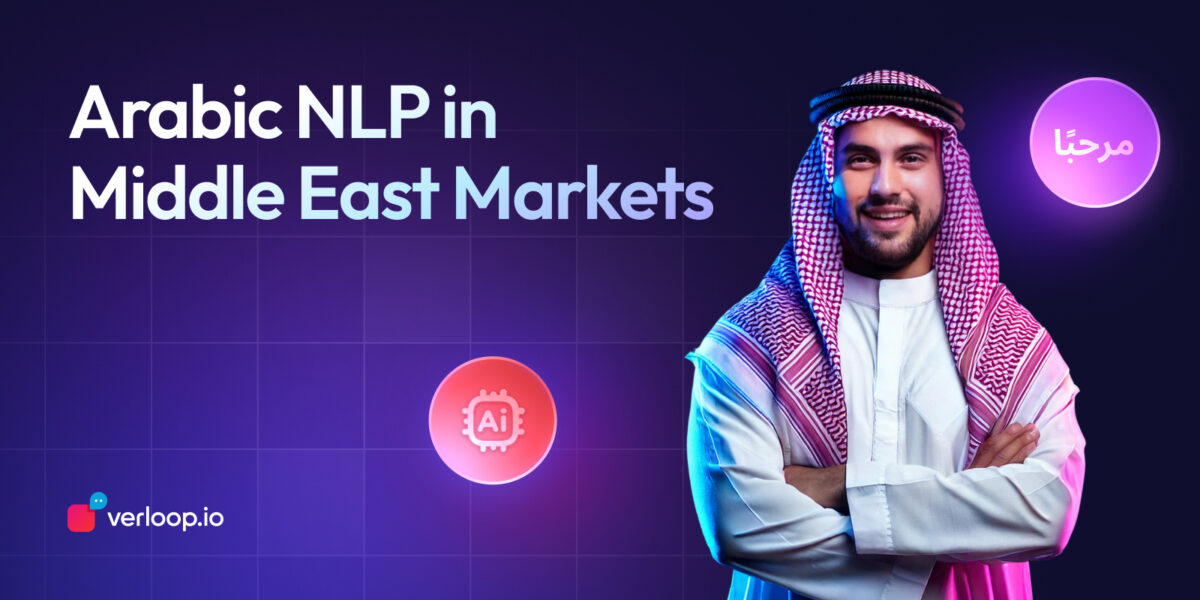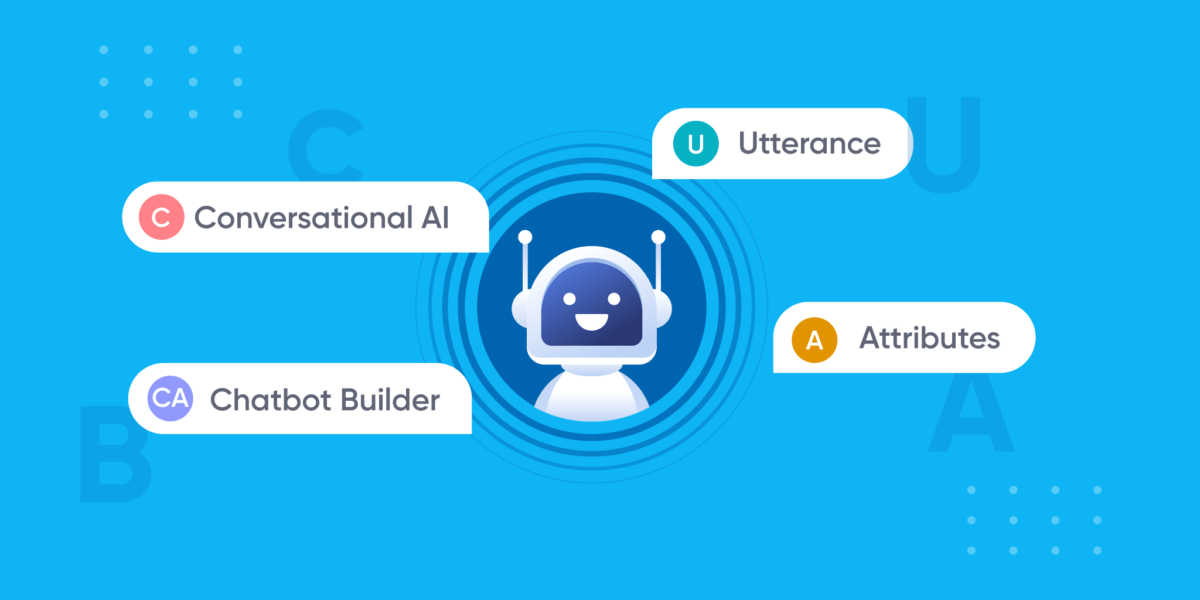
Arabic NLP for Middle East Markets
- July 31st, 2025 / 5 Mins read
-
 Aarti Nair
Aarti Nair
Arabic isn’t just one language. It’s a rich tapestry of voices spread across regions, cultures, and histories. With over 30 distinct dialects spoken globally, Arabic can sound strikingly different from one country to the next. These dialects typically fall into five main regional categories: Levantine, Egyptian, Maghrebi, Gulf, and Mesopotamian. While Modern Standard Arabic (MSA) serves as the formal language of news, education, and official documents, it’s the local dialects that dominate everyday conversation.
This linguistic diversity, while culturally rich, presents real challenges for technology, especially in the field of Natural Language Processing (NLP). Many dialects are not mutually intelligible, and historical influences from languages like French, English, and Turkish have further shaped vocabulary and syntax.
So, when we talk about building effective AI agents or voice assistants for the Middle East, we’re not just translating — we’re decoding a complex, layered language system. And that’s exactly where Arabic NLP has changed from generic models to context-aware, dialect-specific intelligence.
TL;DR: Why Arabic NLP Matters
Arabic is spoken by over 491 million people across 22+ countries—yet only 0.5% of NLP research focuses on it. With 30+ dialects, unique scripts, and rich cultural context, building AI agents for Arabic isn’t just about translation—it’s about localisation.
From banks in Saudi using Gulf Arabic voicebots to Egyptian e-commerce platforms deploying dialect-specific chatbots, Arabic NLP is unlocking real business impact. But for true progress, we need more regional data, dialect-aware models, and cross-border collaboration.
Arabic NLP is no longer optional—it’s the key to inclusive, effective AI in the Middle East.
Why Arabic NLP Is Different?
Building NLP systems for Arabic isn’t just a translation task — it’s a linguistic puzzle with layers of complexity. Despite being the 4th most used language online and spoken by over 491 million people, only about 0.5% of NLP research is focused on Arabic. This gap creates real-world limitations in how effectively AI can understand and interact with Arabic-speaking users.
So, why is Arabic NLP particularly challenging?
Let’s unpack the key reasons:
1. Morphological Complexity
Arabic is a root-based language. Words are formed by inserting root letters into patterns, creating dense meanings with just a few characters. This flexibility adds richness but makes tokenisation and lemmatisation more difficult for NLP systems.
2. Extreme Dialect Diversity
From Egyptian to Maghrebi to Gulf Arabic, dialects vary dramatically in vocabulary, grammar, and pronunciation. Some dialects are so distinct that even native speakers from different regions may struggle to understand each other. Standard NLP models trained on Modern Standard Arabic (MSA) fall short when applied to these dialects, which dominate daily speech and online interactions.
3. Lack of Vowels = Ambiguity
Written Arabic typically omits short vowels (diacritics), which can make identical letter sequences mean entirely different things. For example, “كتب” can mean “he wrote” or “books” depending on context — a nuance hard for machines to catch.
4. Right-to-Left Script Challenges
Arabic is written right to left, which complicates text alignment, model training, and even UI/UX design for AI applications. Preprocessing Arabic text correctly is often an overlooked but critical step.
5. Frequent Code-Switching
In countries like Morocco or the UAE, Arabic speakers often switch between Arabic and French or English, even mid-sentence. This blending of languages requires NLP models to be multilingual and context-aware.
These linguistic and technical hurdles mean that Arabic NLP solutions can’t simply be adapted from English or European models. They must be purpose-built with regional, dialectal, and script-specific intelligence.
Key NLP Tasks for Arabic AI Agents
Creating effective Arabic AI agents isn’t just about plugging in language data — it requires mastering specific NLP tasks that can handle the language’s structure, variety, and ambiguity. Let’s explore the most critical ones:
1. Automatic Speech Recognition (ASR)
To enable voice-based agents, Arabic ASR systems must handle dialect shifts, rapid speech, and regional pronunciations. For example, Egyptian Arabic turns the letter ج into a hard “g” (as in “gamal” instead of “jamal”). Gulf dialects swap ق for a “g” sound, while Levantine speakers may soften ق into a glottal stop. ASR models need to be trained across dialectal corpora to manage this variability.
2. Named Entity Recognition (NER)
Arabic names and places often have multiple variants (e.g., محمد, Mohamed, Muhammad) and may include prefixes like “Al-”. An NLP system must understand that “Al-Masry Al-Youm” is a newspaper, not just a string of common words.
3. Part-of-Speech (POS) Tagging
Arabic’s complex morphology means a single word can contain a verb, subject, and object. Take وكتبناها (“and we wrote it”) — that’s one word containing a conjunction, verb, subject, and an object. POS tagging helps break this down so the AI understands who’s doing what.
4. Machine Translation
Arabic-to-English (and vice versa) translation is a common use case for Middle Eastern businesses. However, literal translations can lose meaning across dialects or sound unnatural. High-quality translation models must balance linguistic accuracy with contextual understanding.
5. Intent Recognition
Arabic customers may express intent indirectly or with idiomatic phrases that differ across regions. Recognising whether a user wants to “file a complaint” versus “ask for help” requires training on real customer conversations across dialects.
6. Text Normalisation and Tokenisation
Arabic text often includes:
Diacritics (optional but important)
Variations in spelling (e.g., with or without hamza)
Numbers mixed with text (e.g., Arabizi: “7abibi” for “حبيبي”)
Text preprocessing must account for all these cases to ensure clean input for downstream models.
Together, these tasks form the core of a functional Arabic NLP pipeline. Only by tackling each can we create AI agents that truly speak the user’s language, in every sense of the phrase.
Challenges and Data Gaps in Arabic NLP
Building AI agents for Arabic isn’t just a technical challenge — it’s a linguistic puzzle layered with cultural nuance, under-resourced dialects, and fragmented data.
Let’s look at what’s holding the ecosystem back:
1. Dialects ≠ One Dataset
Most publicly available datasets are built on Modern Standard Arabic (MSA) — the formal variety used in media, government, and schools. But day-to-day conversations in customer service, e-commerce, and social media happen in dialects, like Egyptian or Levantine Arabic.
⚠️ The problem? An AI trained only on MSA can misinterpret informal requests, fail to understand slang, or respond too formally in casual contexts.
2. Low-Resource Language in NLP
As we have seen before, despite being the 4th most used language online, Arabic accounts for less than 0.5% of NLP research datasets and pre-trained model benchmarks.
Why?
Scarcity of open-source datasets, especially annotated ones
Tokenisation and morphology complexities
Diverse writing styles (script variants, Arabizi, missing diacritics)
3. Bias Toward English in AI Development
Most foundational models (like GPT or BERT) were trained on English-heavy corpora. Even multilingual models often underperform in Arabic due to:
Imbalanced training
Limited fine-tuning on Arabic data
Poor dialectal variation coverage
4. Lack of Standard Benchmarks
While English has GLUE, SuperGLUE, and MMLU, Arabic lacks consistent benchmarks for evaluating conversational agents, especially for dialectal understanding, sentiment, and ASR accuracy.
The result?
Arabic-speaking users often experience AI systems that:
Misunderstand context
Respond in unnatural tones
Ignore local norms and idioms
This is not just a usability issue — it’s a missed opportunity in markets where digital adoption is accelerating.
Next up: let’s explore what’s being done to bridge these gaps and what tools developers can start using today.
Building Blocks of Arabic NLP: Tools, Models, and What’s Possible
Arabic NLP is having its moment. For years, the language was underserved in the world of AI, overshadowed by English, Chinese, and a few European counterparts. But that’s starting to change — and quickly.
With over 491 million speakers and massive online and offline influence, Arabic is far too important to be an afterthought. From smart assistants that understand Egyptian slang to customer support bots fluent in Gulf Arabic, real progress is being made.
Let’s explore the ecosystem of tools and models that are powering this shift.
Foundation Models Leading the Charge
Think of pre-trained models as the brain behind your AI — they’re what helps machines understand, interpret, and generate language. And now, Arabic has a few brilliant ones trained just for it.
Popular Arabic Foundation Models:
| Model | What It’s Good At | Why It Matters |
|---|---|---|
| AraBERT | Modern Standard Arabic (MSA) classification, NER, sentiment analysis | Built on Arabic Wikipedia, news articles, and large web corpora |
| MARBERT | Dialect detection, social media sentiment | Trained on over 1 billion tweets — it’s your go-to for casual and regional Arabic |
| QARiB | Question answering, paraphrasing | Helps build customer support and knowledge bots that sound more natural |
| ArabicBERT | Light classification tasks | Lightweight and great for smaller-scale projects |
| GLM-AR | Multilingual tasks with Arabic alignment | Useful if your bot switches between Arabic and English mid-sentence |
These models act as the starting point for many NLP applications — from chatbots to voice agents.
Toolkits That Handle the Heavy Lifting
You don’t need to build every component from scratch. Whether it’s breaking down complex Arabic morphology or detecting dialect, these toolkits simplify the hard stuff.
Notable Toolkits and Resources:
Farasa: Fast and reliable for part-of-speech tagging, diacritization, and tokenization — especially for MSA.
CAMeL Tools: Offers powerful capabilities like dialect identification, morphological analysis, and named entity recognition.
MADAR Corpus: A multilingual, multi-dialect corpus that’s perfect for training bots to understand the nuances across regions.
AraT5: Great for text generation and summarisation in Arabic using the T5 architecture.
ALT Arabic Corpus: A clean, aligned dataset ideal for translation and multi-lingual chatbot training.
Together, these tools bring structure and linguistic understanding to the table — essential for tasks like intent recognition and response generation.
APIs and SaaS That Speak Arabic
Not every team has the bandwidth to build models from scratch — and that’s okay. Several platforms offer Arabic NLP as a service.
Verloop.io: Offers end-to-end Arabic automation across chat, WhatsApp, and voice, with dialect-sensitive understanding and generative AI fallback.
Google Cloud Translate / Amazon Comprehend: Basic support for MSA; decent for generic translation and entity detection, but not dialect-aware.
Azure Cognitive Services: Supports Arabic transcription and translation, with limited dialect accuracy.
🗣️ Pro tip: Choose SaaS tools that mention “Arabic dialect” or “conversational Arabic” explicitly — not just MSA — to ensure accuracy in real-world usage.
Arabic NLP isn’t just about having the right models. It’s about understanding which dialect you’re targeting, what your bot needs to do, and where it will live (chat, voice, app, etc.).
With tools like AraBERT, CAMeL, and platforms like Verloop.io, teams can now build AI agents that go beyond basic FAQs and into rich, dialect-aware conversations.
Why Arabic NLP is Gaining Ground in the Middle East?
As digitisation accelerates across the Middle East, businesses are under growing pressure to communicate better—and faster. But when your customers speak in dozens of dialects, from Gulf Arabic to Maghrebi, generic chatbots and English-first tools just don’t cut it.
Here’s where Arabic NLP is stepping in—and why it’s becoming a necessity.
1. Smarter Customer Support Across Dialects
Imagine a telecom provider in Saudi Arabia. A customer calls in speaking Najdi Arabic, asking about a billing discrepancy. Traditional IVRs route the call to a generic agent, often leading to long wait times and miscommunication.
Now picture an Arabic voice bot trained on Gulf dialects that immediately understands the query, pulls up the latest invoice, and explains the charges—all before a human ever picks up.
That’s the impact of Arabic NLP in customer support: quicker resolutions and a better customer experience without language barriers.
2. AI Voice Agents for First-Level Contact Handling
Contact centres are expensive to scale—especially when they serve users across Saudi Arabia, the UAE, Egypt, and Lebanon. Each region has its own way of saying things, even if the intent is the same.
A bank in Riyadh could deploy a voice bot trained in both MSA and Gulf dialects to handle basic queries like “How much is in my account?” or “Where’s the nearest ATM?”. This frees up human agents to focus on more complex issues while reducing customer wait time.
3. Search and Chat Assistants for E-commerce
An online fashion retailer in Cairo receives thousands of searches daily—some typed in English, others in Franco-Arabic like “abaya black chiffon” or “شنطة سفر”. With a generic search engine, results might be irrelevant or mismatched.
By integrating Arabic NLP, that same platform could understand the intent behind mixed-language or dialectal queries, recommend the right product instantly, and even upsell related items via chat.
4. Government e-Services in the Language of the People
Let’s say a citizen in Sharjah wants to renew their vehicle registration. They message a government WhatsApp bot—but they’re more comfortable using colloquial Emirati Arabic than formal MSA.
An AI agent that recognises both can guide them through the process in a conversational tone, confirm details, and even redirect to payment—all within minutes.
This isn’t just convenient—it makes services more inclusive, especially for populations who don’t regularly use MSA.
5. Localised Learning in EdTech Platforms
A student in Morocco is using an Arabic learning app. The video content is in MSA, but she’s more familiar with Darija (Moroccan Arabic). With Arabic NLP, the platform could automatically subtitle or summarise lessons in her dialect—making it easier to learn and retain information.
Content providers and edtech startups across the region are starting to see how dialect-aware NLP can personalise learning at scale.
As these examples show, the demand isn’t abstract. It’s rooted in real challenges that Arabic-speaking businesses, governments, and communities face every day. And Arabic NLP isn’t just solving for efficiency—it’s helping brands show up in the language that feels most familiar to their users.
What Businesses Can Do Today?
Arabic NLP has come a long way—but it’s still evolving. For businesses in the Middle East, waiting for “perfect” language models isn’t practical. The real question is: what can you do today to serve Arabic-speaking customers better?
Here are five strategic actions businesses can take—starting now.
1. Fine-Tune Open-Source Arabic Models with Local Data
You don’t have to start from scratch. Models like AraBERT or CAMeL Tools already offer a solid foundation in Arabic NLP. By training them further on your own customer data—whether it’s Gulf Arabic support tickets or Levantine WhatsApp chats—you can significantly improve accuracy and contextual understanding.
Example: A Jordanian telecom company could feed its chatbot past transcripts in Jordanian dialect to better handle common phrases like “ليش ما في شبكة؟” (Why is there no signal?).
2. Use a Hybrid NLP Approach: MSA + Dialect Detection
Modern Standard Arabic works well for structured tasks like billing or form filling. But for real-time chat or voice, dialects dominate. Combine both—MSA for backend structure and dialect-aware models for frontend interaction—to get the best of both worlds.
For instance, an AI agent on an Egyptian ecommerce site can greet users in local dialect but switch to MSA when summarising invoice details.
3. Build Smarter Voice Bots Using ASR + NLP + NLU
Voice AI isn’t just about speech recognition. It’s about understanding intent across accents and dialects. Businesses in GCC countries can combine automatic speech recognition (ASR) with natural language processing (NLP) and natural language understanding (NLU) to enable smarter, multilingual voice agents.
A UAE-based bank might deploy a voice bot that hears “وين أقرب فرع؟” and immediately returns the nearest branch location—without any human input.
4. Partner with Arabic-Focused AI Vendors
Generic chatbot tools won’t cut it. Consider working with vendors who specialise in Arabic NLP and support regional dialects. They often have pre-trained models, regulatory familiarity, and existing integrations that can help you move faster.
5. Choose AI Agents Trained in Arabic and Multilingual Capabilities
Many modern AI agents come with multilingual support out of the box. Look for those that can be trained on Arabic scripts, dialect-specific intents, and use cases—from customer support to outbound campaigns.
Platforms like Verloop.io already offer multilingual, omnichannel AI agents that understand context, tone, and dialect—making them a smart starting point for Middle East brands.
These aren’t moonshot strategies—they’re practical next steps for teams looking to bridge the gap between global AI trends and local customer needs. The tools exist. The models are improving. And the opportunity to lead is wide open.
Building Foundation Models in Arabic
The journey of Arabic NLP is only just beginning—and the next chapter lies in building robust, Arabic-first foundation models. While many current AI systems rely on multilingual transformers with patchy dialect support, the Middle East is stepping up to create its own AI backbone.
Regional Research is Picking Up Pace
Institutions like King Abdullah University of Science and Technology (KAUST) and Mohamed bin Zayed University of Artificial Intelligence (MBZUAI) are pioneering efforts to develop large Arabic language models from the ground up. These models are trained on high-quality, region-specific datasets, covering everything from Gulf Arabic call transcripts to classical religious texts.
These aren’t just research exercises—they’re the beginning of regional autonomy in AI innovation.
Startups Are Primed for Niche Innovation
The diversity of dialects offers startups a unique edge: the ability to build domain-specific agents in sectors like banking, logistics, and retail. Imagine a smart assistant fluent in Moroccan Darija that handles microloans, or a voice bot trained exclusively on healthcare queries from Saudi clinics.
Startups that embrace these niche opportunities can leapfrog global competitors who struggle with dialectal nuance.
Governments and Enterprises Are Fueling the Ecosystem
From Vision 2030 in Saudi Arabia to the UAE’s National AI Strategy, Middle Eastern governments are actively investing in AI capabilities. Whether through public-private partnerships, national datasets, or dedicated funding arms, the push to localise AI is real—and accelerating.
The next foundational Arabic model might just emerge from a Riyadh-based cloud lab or a Cairo NLP startup, not Silicon Valley.
The Rise of Multimodal Arabic Models
The future isn’t just text-based—it’s multimodal. This means combining text, speech, and visual inputs to create more natural, immersive interactions. Think of a support bot that not only understands spoken Iraqi Arabic but can also read a document and extract relevant info for the customer.
These models will power everything from video-based learning agents to visual product assistants that help customers navigate shopping apps in dialect-rich interfaces.
In short: the next wave of AI innovation in the Arabic-speaking world will be built by the region, for the region. The tools, funding, and talent are in place. What’s needed now is bold execution.
Unlocking Arabic NLP’s Full Potential
Arabic NLP isn’t just about translating language—it’s about understanding identity, context, and nuance in one of the world’s most linguistically rich regions. From the fragmented nature of dialects to the underrepresentation in global AI research, the path to building truly intelligent Arabic AI agents is filled with both challenges and unprecedented opportunities.
As digital adoption surges across the Middle East, businesses—whether a Saudi bank automating inbound calls in Gulf Arabic or an Egyptian fashion platform launching a WhatsApp bot in local dialect—are beginning to realise the strategic value of Arabic-first AI.
But to truly unlock this potential, we need more than translation layers. We need:
Locally trained foundation models
Dialect-aware training datasets
Multimodal AI systems
And most importantly, collaboration between academia, startups, and enterprises
With regional investment on the rise and research ecosystems maturing, Arabic NLP is poised to become a force multiplier—not just for language access, but for building inclusive, locally relevant AI experiences.
🟡 The next frontier in global AI won’t be built in one language—it will speak in many dialects. Arabic is ready.
Frequently Asked Questions about Arabic NLP
1. Why is Arabic NLP more complex than other languages?
Arabic has over 30 dialects with significant variation in vocabulary, grammar, and pronunciation. This, combined with its rich morphology and script, makes NLP tasks more challenging compared to languages like English.
2. What’s the difference between Modern Standard Arabic and dialects?
Modern Standard Arabic (MSA) is the formal, written version used in media, education, and official documents. Dialects are region-specific and used in everyday speech, often differing widely across countries.
3. Which Arabic dialects are most commonly targeted by AI developers?
Egyptian Arabic (due to media influence), Gulf Arabic (for financial applications), and Levantine Arabic (for social apps and support bots) are among the most prioritised due to their widespread use and market demand.
4. Can AI agents understand and respond in different dialects?
Yes, but this requires dialect-specific training data and models. Some platforms now support multilingual and multi-dialect capabilities, but performance varies by dialect and use case.
5. What industries benefit most from Arabic NLP?
Banking, e-commerce, telecom, healthcare, and government services in MENA benefit significantly—especially in automating support, personalising content, and improving accessibility.
6. How can I start building an Arabic-capable AI chatbot or voicebot?
Begin with a platform that supports Arabic NLP (both MSA and dialects), integrate it with relevant channels like WhatsApp or voice, and use regionally tuned datasets to improve accuracy.






